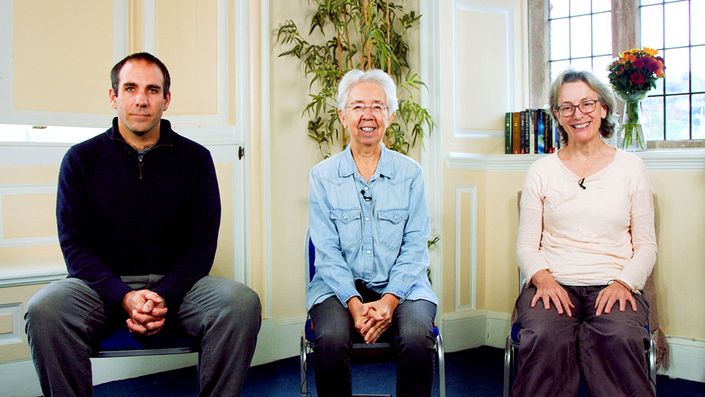RAIN: The Nourishing Art of Mindful Inquiry
Learn an accessible, deeply freeing way to practice mindfulness.
What is RAIN?
RAIN stands for Recognition, Acceptance, Interest, and Non-Identification. These are the qualities that make up a moment of mindfulness. Because of its simplicity and power, RAIN has become recommended by meditation teachers worldwide as a helpful approach to steering us through challenging emotions and situations.
This 6-part online course is an opportunity to learn and deepen this practice under the guidance of Vipassana teacher Michele McDonald, who first coined the RAIN acronym.
Enroll now to start your journey with RAIN today.

A recipe for mindfulness
Emotions are so wrapped up with our everyday experience that the two often seem inseparable. RAIN, a widely used approach developed by Vipassana teacher Michele McDonald, offers practitioners of all skill levels a way to investigate our emotional lives, so we can better regulate the instinctive reactions that cause stress and confusion.
What to expect
Each unit includes video teachings, guided meditations, prompts for reflection, opportunities for group discussion, and optional quizzes to consolidate what you have learned.
The RAINDROP Acronym
RAINDROP makes the wisdom of the Buddha's mindfulness available to us all. It is profoundly deep and yet easy to put into practice in the midst of living.
| R | Recognition | What is really happening? |
| A | Acceptance | Can we accept that it's happening? |
| I | Interest | Can we bring genuine interest to what's happening? |
| N | Non-identification | Is this happening to "me," or is it simply happening? |
| D | Distraction | The opposite of recognition. Are we aware of our experience? |
| R | Resistance | The opposite of acceptance. Are we resisting reality? |
| O | Obliviousness | The opposite of interest. Do you care about what's happening? |
| P | Personification | The opposite of non-identification. Taking things personally. |

About RAINDROP
Since creating the RAIN teaching, Michele has expanded the acronym to RAINDROP, which includes Distraction, Resistance, Obliviousness, and Personification. Rather than thinking of these factors as problems or enemies to combat, we can understand them as conditioned defenses that we can investigate. No matter how many hours we may devote to formal practice on the cushion, in reality, we spend most of our waking hours distracted, resistant, and somewhat oblivious to what’s actually happening around us. RAINDROP charts out a way for us to steer through the emotions that rattle us and to respond—rather than react—from a place of greater balance and grace.
Course Features

An expert teacher
Michele McDonald is a respected meditation instructor and creator of the RAIN and RAINDROP acronyms.

Guidance for personal practice
6 videos offering guided meditations and exercises to deepen your personal practice.

Video dharma talks
18 videos in which Michele describes the basics and nuances of mindful investigation with RAINDROP.

Downloadable guided meditations
Feel your way into each aspect of RAIN with support from Michele. You can take these meditations with you anywhere.

Walking meditation instruction
RAIN can be a powerful tool to bring to walking practice. Michele guides us in this essential but often overlooked aspect of practice.

Clear guidance for living mindfully
Simple flowcharts, instructions, and diagrams give you the clarity needed for purposeful practice.

Meet Michele, Your Teacher
Michele McDonald co-founded Vipassana Hawaii in 1984 with Steven Smith and is now enjoying developing a small temple on the northern tip of Hawaii’s Big Island. She has taught Insight meditation for 32 years. Beyond her commitment to the Vipassana Hawaii Sangha, she teaches extensively throughout the United States as well as in Canada, Burma, and various locations around the world. Michele has been a quiet pioneer, having been the first woman to teach a formal retreat in Burma, side-by-side Sayadaw U Lakkhana, a master teacher and abbot of Kyaswa Monastery.
Having worked with a wide range of Asian and Western teachers, Michele is most inspired by her practice with Dipa Ma and Sayadaw U Pandita and more recently in Burma with Mya Taung Sayadaw. She appreciates teaching at many levels of practice and has enjoyed leading three-month retreats for experienced students as well as developing meditation retreats for young people. Her style of teaching emphasizes helping individuals find entry points into stillness that are natural for them. She encourages an understanding of the path rooted in insight as well as a gentle strengthening of mindfulness and concentration so that people can ultimately access a deep sense of peace in every moment. Michele is thrilled when students begin to love their practice as their own.
A Note From the Editor
We've all heard the benefits of mindfulness many times over, but for many of us questions still arise, "How do you actually do it?" "What should I do once the mind is peaceful?" "How do I practice when mindfulness seems impossible?" Michele McDonald saw the real-world questions and difficulties that every practitioner has and created the RAIN acronym: a precise recipe for relating to our experience mindfully. In this online course, Michele unpacks and expands on this acronym, offering valuable insight into her approach.
This has long been one of my favourite Tricycle courses. Rarely has anyone offered a clearer account of the actual nuts and bolts of what mindfulness looks like in our moment-to-moment experience. And, while firmly grounded in the Burmese Mahasi tradition, the emphasis here is not on scholarship or esoterica. What Michele offers is a way to wholeheartedly live the teachings.
—Mark Cooper, Course Designer
Testimonials
What a great course! Michele is excellent. The resources were very helpful.
This was an incredible course experience with Michele. She offered a wide lens view of RAIN through the videos, guided meditations, charts, reflect questions and the two live calls. I feel like I have a much better understanding of RAIN as compared to before the course. I look forward to taking to this practice, as Michele suggests as a lifelong practice, and will be reviewing the materials as needed.
I really appreciated the course. I think this course suited my level of practice very much. The clarifications on technique and terminology was very helpful. I am also very grateful for and inspired by Michele's kindness in the way she presented the material.
I so enjoyed this teaching and Michele did an outstanding presentation of this concept of RAIN. These teachings are enhancing my daily practice and I am so grateful.
I gained many wonderful insights from your teachings.
Wow! Well presented, well organized, balanced use of written, visual materials and video recordings. I feel so grateful that this course offering came to my attention.
How the Journey Unfolds
Detailed Curriculum
- Welcome to RAIN: The Nourishing Art of Mindful Inquiry
- Introduction to RAINDROP
- The RAINDROP Acronym (8:28)
- "R" is for Recognition (5:17)
- Downloads
- The Three Rs (3:26)
- Soft Mental Notes (7:34)
- Meditation 1
- Anchoring (7:07)
- Check Your Understanding
- Being Grateful for Drop (6:29)
- Practice Instructions (1:45)
- Meditation 2
- Reflect
- Discussion
- Summary
- Introduction
- N Is for Nonidentification (9:58)
- Soft Readiness (1:54)
- A Story About Reactivity and Identification (2:17)
- P Is for Personification (5:54)
- A Story About Preferences and Non-Identification (8:14)
- Check Your Understanding
- Practice Instructions (2:28)
- Meditation 6 (16:22)
- Reflect
- Discussion
- Summary
- Introduction
- Taking RAINDROP as a Lifelong Practice (14:17)
- RAIN Is Not Passivity (1:50)
- A Story About Mahasi Sayadaw (1:32)
- Reflect on the RAINDROP Practice Chart
- Check Your Understanding
- In Support of the Rohingya and Interfaith Dialogue in Burma (2:27)
- Discussion
- Thank You (0:36)
- Summary
- Discover Tricycle: The Buddhist Review
- Refer a Friend
- Your Next Course (1:19)
Related Courses
You may also be interested in these online courses from Tricycle: The Buddhist Review.





